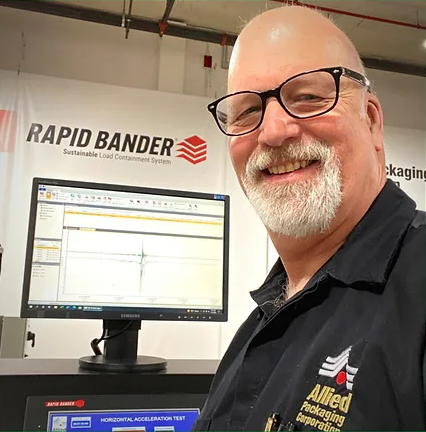Ask Steve
November 22, 2023
Question from Alfred: I’m constantly told by salespeople that downgauging our stretch wrap will save us money. What are the risks (pitfalls/potential issues) of downgauging stretch wrap to reduce film costs?
Hi Alfred, I am sure everyone reading this has had the same thing presented to them at some point by a salesperson selling stretch film. While that may be true on paper, let’s explore what really happens when you downgauge film.
If you apply the same number of wraps at the same tension and total stretch, the film weight will be reduced, that is a fact. However, the reduction in the cost per pallet of stretch film will not track the reduction in film weight one-for-one. When thinner films are produced, the output in pounds (or yield) per hour is reduced. That translates to a reduction in the manufacturer’s revenue if the price per pound is not increased for thinner films. Adding to that, thinner films tend to be more difficult to run, further reducing yield and their revenue. Do you think they will sell thinner gauge film to you for the same price per pound, out of the goodness of their heart, or do you think they will charge more per pound for thinner gauge films? Some suppliers will disguise the increase in price per pound by adjusting roll length, so you may pay the same price per roll, but will have less footage, as an example. The only cost that matters, and what you should base decisions on, is your Stretch Film Cost Per Pallet. That number takes away all the smoke and mirrors.
Unless the manufacturer has the latest technology in place, there will be variations in the film which can manifest themselves in several unwanted ways, any, or all of which can impact your operation. The thinner the film, the more likely you will experience problems like ragged edge profiles, gauge bands, or imperfections such as gels. These will lead to web breaks, taxing your operators, generate film waste, and constrain your plant’s output.
Now, for a minute, let’s assume the film producer is willing to sell thinner film at the same price per pound, and let’s assume that they have the equipment and process to produce the thinner film defect free, what other issues might you experience with downgauged film?
Again, if you apply the same number of wraps at the same tension and total stretch, there will be a reduction in Force-to-Load. That is the amount of “unitizing” force the film applies to the load, one of the two primary load containment drivers. You can always apply more wraps to achieve the same Force-to-Load that you have now, but then you are adding film weight (cost), and more machine time (reduced machine throughput), defeating the whole purpose of downgauging.
The thinner the film, the more likely you will experience web breaks during wrapping. The corner of a pallet, corner of a corrugated tier sheet, corner of a tray or box or bag will puncture the film and immediately break the web. It normally takes several minutes for an operator to reconnect the web and resume wrapping. During this time, you are losing production, in addition to wasting the film applied to the load before the break.
If you do not change your settings (tension, number of wraps, etc.), the unitizing force the downgauged film applies to the load is reduced (it is a matter of physics). This reduction allows movement of the product when forces are applied during transportation. Layers of product will shift along the direction of force, which also shifts the center of gravity. This shift of the center of gravity places more downforce on the leading edge of the product (on the bottom layer). The more the shift, the more the force, until the added force exceeds the limit the product packaging can withstand, and when that happens you have a load failure. You know the cost of your product and the impact that a load failure represents, or the impact of a customer rejecting a shipment because the product is scattered all over the trailer.
By following the logic, let’s review what we have learned about downgauging film:
- The only true metric to consider is the Stretch Film Cost Per Pallet, not cost per pound or cost per roll.
- The reduction in weight per pallet does not equal a reduction in the cost of film per pallet.
- The thinner the film, the more likely you will experience defects, which will have a financial impact by disrupting your operation.
- Web breaks are much more likely to occur with downgauged film, which will have a financial impact by disrupting your operation.
- Reduction in Force-to-Load from downgauging can lead to load failure during transportation which has not only a financial impact, but it also damages customer goodwill.
- Anytime you downgauge, you typically sacrifice something.
When you are evaluating your stretch film cost, here is something you should consider. In the bigger picture, you are not paying for stretch wrap, you are really paying for load containment. Load containment should be your highest priority. The amount of film required to achieve your load containment standard is the driver, the stretch film cost per wrapped pallet is the result. That is true no matter how much load containment you need. If you don’t need a lot of containment, then your film cost per pallet will be low, however, if you cannot afford a load failure, your load containment standard should be high, and your film cost per pallet will reflect that. So, you cannot evaluate stretch film cost without first considering your load containment needs, or another way to say that; you cannot judge stretch film cost outside the context of your load containment standard.
There is an alternative to consider which will help you achieve the load containment you require, while reducing the number of wraps, films weight, cost per pallet, and virtually eliminating web breaks. We have had great success over the years doing just that with our Rapid Bander, Rapid Roper, Rapid Roper Plus technology. Not only has it been proven in the lab, but it has been proven in the field, at companies in your very market segment. We will be happy to come to your facility, evaluate your stretch wrap process and provide you with a complete Value Analysis which addresses cost per pallet, load containment, machine throughput, and film reduction, so you can make an informed decision based on verifiable facts – no smoke and mirrors.
Thanks for asking!








